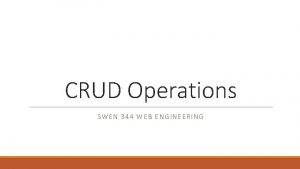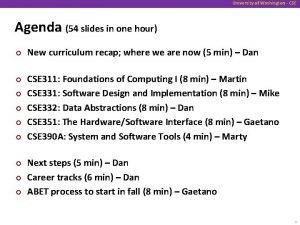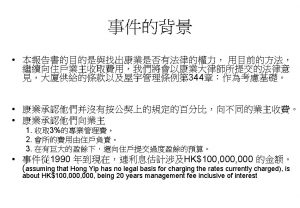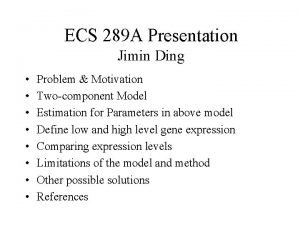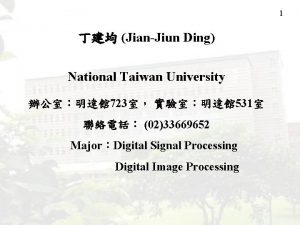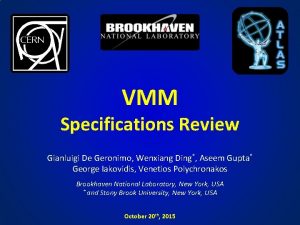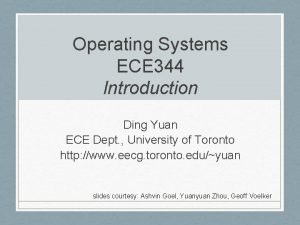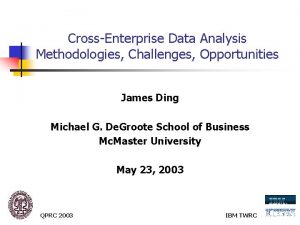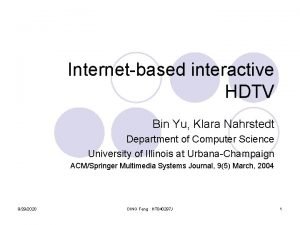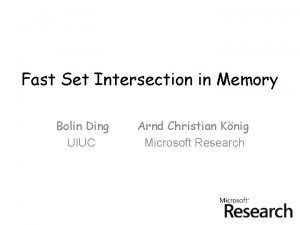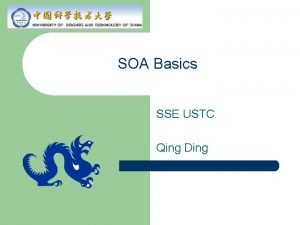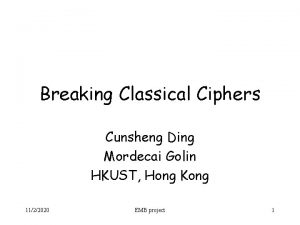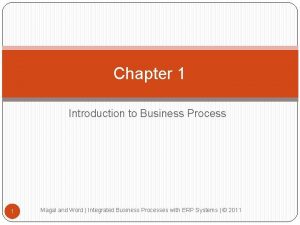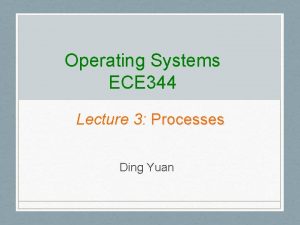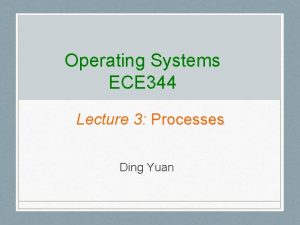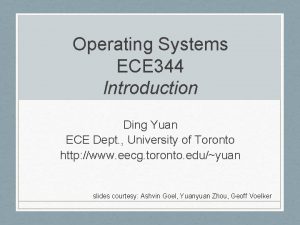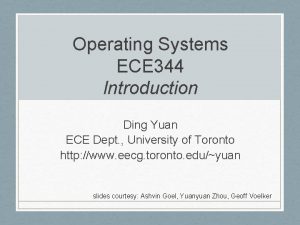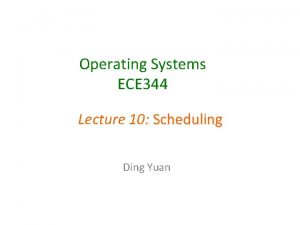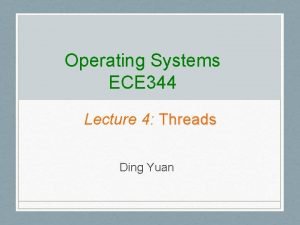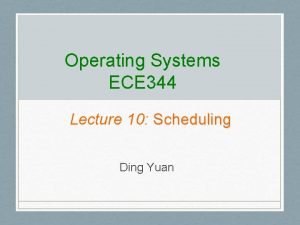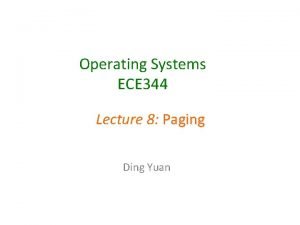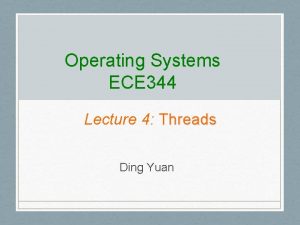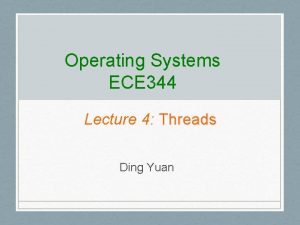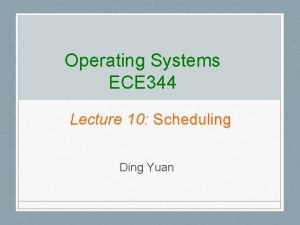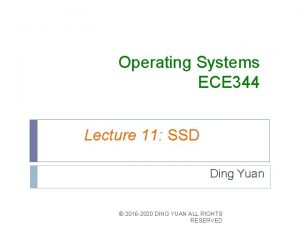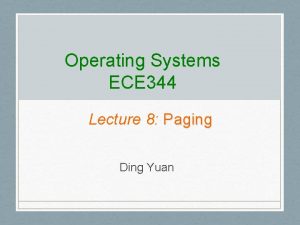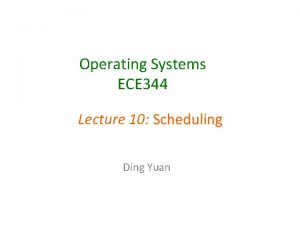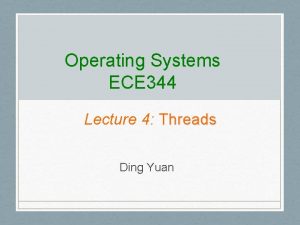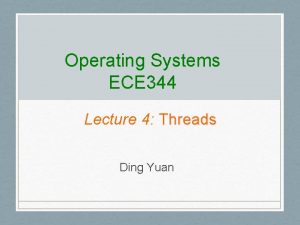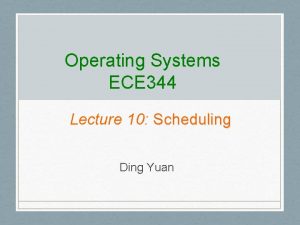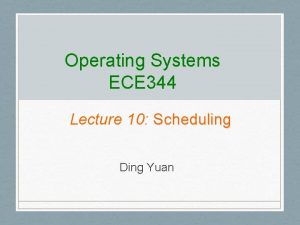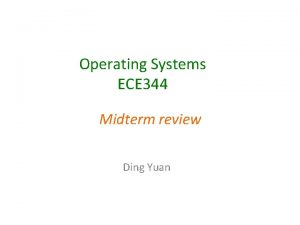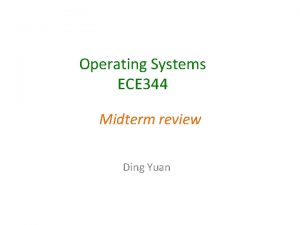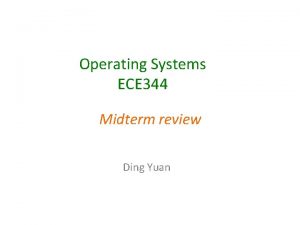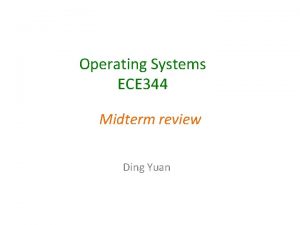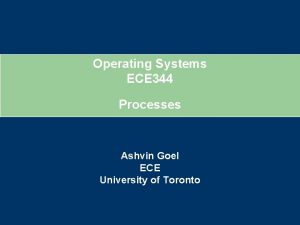Operating Systems ECE 344 Lecture 3 Processes Ding













![Now how about this? int myval; int main(int argc, char *argv[]) { myval = Now how about this? int myval; int main(int argc, char *argv[]) { myval =](https://slidetodoc.com/presentation_image_h2/49ac482dfdee97d72b021a0cce67de68/image-14.jpg)

















![fork() int main(int argc, char *argv[]) { char *name = argv[0]; int child_pid = fork() int main(int argc, char *argv[]) { char *name = argv[0]; int child_pid =](https://slidetodoc.com/presentation_image_h2/49ac482dfdee97d72b021a0cce67de68/image-32.jpg)












- Slides: 44

Operating Systems ECE 344 Lecture 3: Processes Ding Yuan

Processes • This lecture starts a class segment that covers processes, threads, and synchronization • These topics are perhaps the most important in this class • You can rest assured that they will be covered in the exams • Today’s topics are processes and process management • • What are the units of execution? How are those units of execution represented in the OS? What are the possible execution states of a process? How does a process move from one state to another? 2 Ding Yuan, ECE 344 Operating System

Users, Programs • Users have accounts on the system • Users launch programs • Many users may launch the same program • One user may launch many instances of the same program • Then what is a process? 3 Ding Yuan, ECE 344 Operating System

The Process • The process is the OS abstraction for execution • It is the unit of scheduling • It is the dynamic execution context of a program • A process is sometimes called a job or a task or a sequential process • Real life analogy? 4 Ding Yuan, ECE 344 Operating System

Analogy: A robot taking ECE 344 • Program: steps for attending the lecture • Step 1: walk to RS 211 • Step 2: find a seat • Step 3: listen (or sleep) • Process: attending the lecture • Action • You are all in the middle of a process 5 Ding Yuan, ECE 344 Operating System

Mac. OS example: Activity monitor 6 Ding Yuan, ECE 344 Operating System

Linux example: ps 7 Ding Yuan, ECE 344 Operating System

So what is a process? • A process is a program in execution • It is one executing instance of a program • It is separated from other instances • It can start (“launch”) other processes • It can be launched by them 8 Ding Yuan, ECE 344 Operating System

Process State • A process has an execution state that indicates what it is currently doing • Running: Executing instructions on the CPU • It is the process that has control of the CPU • How many processes can be in the running state simultaneously? • Ready: Waiting to be assigned to the CPU • Ready to execute, but another process is executing on the CPU • Waiting: Waiting for an event, e. g. , I/O completion • It cannot make progress until event is signaled (disk completes) • As a process executes, it moves from state to state • Unix “ps”: STAT column indicates execution state 9 Ding Yuan, ECE 344 Operating System

Questions • What state do you think a process is in most of the time? • For a uni-processor machine, how many processes can be in running state? • Benefit of multi-core? 10 Ding Yuan, ECE 344 Operating System

Process State Graph Create Process New Ready Unschedule Process Terminated I/O Done Schedule Process Running Waiting I/O, Page Fault, etc. Process Exit 11 Ding Yuan, ECE 344 Operating System

Process Components • Process State • new, ready, running, waiting, terminated; • Program Counter • the address of the next instruction to be executed for this process; • CPU Registers • index registers, stack pointers, general purpose registers; • CPU Scheduling Information • process priority; 12 Ding Yuan, ECE 344 Operating System

Process Components (cont. ) • Memory Management Information • base/limit information, virtual->physical mapping, etc • Accounting Information • time limits, process number; owner • I/O Status Information • list of I/O devices allocated to the process; • An Address Space • memory space visible to one process 13 Ding Yuan, ECE 344 Operating System
![Now how about this int myval int mainint argc char argv myval Now how about this? int myval; int main(int argc, char *argv[]) { myval =](https://slidetodoc.com/presentation_image_h2/49ac482dfdee97d72b021a0cce67de68/image-14.jpg)
Now how about this? int myval; int main(int argc, char *argv[]) { myval = atoi(argv[1]); while (1) printf(“myval is %d, loc 0 x%lxn”, myval, (long) &myval); } • Now simultaneously start two instances of this program • Myval 5 • Myval 6 • What will the outputs be? 14 Ding Yuan, ECE 344 Operating System

15 Ding Yuan, ECE 344 Operating System

Instances of Programs • The address was always the same • But the values were different • Implications? • The programs aren’t seeing each other • But they think they’re using the same address • Conclusions • addresses are not the “physical memory” • How? • Memory mapping • What is the benefit? 16 Ding Yuan, ECE 344 Operating System

Process Address Space 0 x. FFFF Stack SP • Allows stack growth • Allows heap growth • No predetermined division Address Space Heap (Dynamic Memory Alloc) Static Data (Data Segment) Code (Text Segment) PC 0 x 0000 17 Ding Yuan, ECE 344 Operating System

Process Data Structures How does the OS represent a process in the kernel? • At any time, there are many processes in the system, each in its particular state • The OS data structure representing each process is called the Process Control Block (PCB) • The PCB contains all of the info about a process • The PCB also is where the OS keeps all of a process’ hardware execution state (PC, SP, regs, etc. ) when the process is not running • This state is everything that is needed to restore the hardware to the same state it was in when the process was switched out of the hardware 18 Ding Yuan, ECE 344 Operating System

Why we need PCB? • Analogy: car seat memory • If Yao Ming and I share the same car, need to re-adjust seat every time we switch Hardware Process 19 Ding Yuan, ECE 344 Operating System

PCB Data Structure • The PCB contains a huge amount of information in one large structure • • Process ID (PID) Execution state Hardware state: PC, SP, regs Memory management Scheduling Pointers for state queues Etc. 20 Ding Yuan, ECE 344 Operating System

struct proc (Solaris) /* * One structure allocated per active process. It contains all * data needed about the process while the process may be swapped * out. Other per-process data (user. h) is also inside the proc structure. * Lightweight-process data (lwp. h) and the kernel stack may be swapped out. */ typedef struct proc { /* * Fields requiring no explicit locking */ struct vnode *p_exec; /* pointer to a. out vnode */ struct as *p_as; /* process address space pointer */ struct plock *p_lockp; /* ptr to proc struct's mutex lock */ kmutex_t p_crlock; /* lock for p_cred */ struct cred *p_cred; /* process credentials */ /* * Fields protected by pidlock */ int p_swapcnt; /* number of swapped out lwps */ char p_stat; /* status of process */ char p_wcode; /* current wait code */ ushort_t p_pidflag; /* flags protected only by pidlock */ int p_wdata; /* current wait return value */ pid_t p_ppid; /* process id of parent */ struct proc *p_link; /* forward link */ struct proc *p_parent; /* ptr to parent process */ struct proc *p_child; /* ptr to first child process */ struct proc *p_sibling; /* ptr to next sibling proc on chain */ struct proc *p_psibling; /* ptr to prev sibling proc on chain */ struct proc *p_sibling_ns; /* prt to siblings with new state */ struct proc *p_child_ns; /* prt to children with new state */ struct proc *p_next; /* active chain link next */ struct proc *p_prev; /* active chain link prev */ struct proc *p_nextofkin; /* gets accounting info at exit */ struct proc *p_orphan; struct proc *p_nextorph; *p_pglink; /* process group hash chain link next */ struct proc *p_ppglink; /* process group hash chain link prev */ struct sess *p_sessp; /* session information */ struct pid *p_pidp; /* process ID info */ struct pid *p_pgidp; /* process group ID info */ /* * Fields protected by p_lock */ kcondvar_t p_cv; /* proc struct's condition variable */ kcondvar_t p_flag_cv; kcondvar_t p_lwpexit; /* waiting for some lwp to exit */ kcondvar_t p_holdlwps; /* process is waiting for its lwps */ /* to to be held. */ ushort_t p_pad 1; /* unused */ uint_t p_flag; /* protected while set. */ /* flags defined below */ clock_t p_utime; /* user time, this process */ clock_t p_stime; /* system time, this process */ clock_t p_cutime; /* sum of children's user time */ clock_t p_cstime; /* sum of children's system time */ caddr_t *p_segacct; /* segment accounting info */ caddr_t p_brkbase; /* base address of heap */ size_t p_brksize; /* heap size in bytes */ /* * Per process signal stuff. */ k_sigset_t p_sig; /* signals pending to this process */ k_sigset_t p_ignore; /* ignore when generated */ k_sigset_t p_siginfo; /* gets signal info with signal */ struct sigqueue *p_sigqueue; /* queued siginfo structures */ struct sigqhdr *p_sigqhdr; /* hdr to sigqueue structure pool */ struct sigqhdr *p_signhdr; /* hdr to signotify structure pool */ uchar_t p_stopsig; /* jobcontrol stop signal */ 21 Ding Yuan, ECE 344 Operating System

struct proc (Solaris) (2) /* hrtime_t p_mlreal; /* elapsed time sum over defunct lwps */ hrtime_t p_acct[NMSTATES]; /* microstate sum over defunct lwps */ struct lrusage p_ru; /* lrusage sum over defunct lwps */ struct itimerval p_rprof_timer; /* ITIMER_REALPROF interval timer */ uintptr_t p_rprof_cyclic; /* ITIMER_REALPROF cyclic */ uint_t p_defunct; /* number of defunct lwps */ /* * profiling. A lock is used in the event of multiple lwp's * using the same profiling base/size. */ kmutex_t p_pflock; /* protects user profile arguments */ struct prof p_prof; /* profile arguments */ * Special per-process flag when set will fix misaligned memory * references. */ char p_fixalignment; /* * Per process lwp and kernel thread stuff */ id_t p_lwpid; /* most recently allocated lwpid */ int p_lwpcnt; /* number of lwps in this process */ int p_lwprcnt; /* number of not stopped lwps */ int p_lwpwait; /* number of lwps in lwp_wait() */ int p_zombcnt; /* number of zombie lwps */ int p_zomb_max; /* number of entries in p_zomb_tid */ id_t *p_zomb_tid; /* array of zombie lwpids */ kthread_t *p_tlist; /* circular list of threads */ /* * /proc (process filesystem) debugger interface stuff. */ k_sigset_t p_sigmask; /* mask of traced signals (/proc) */ k_fltset_t p_fltmask; /* mask of traced faults (/proc) */ struct vnode *p_trace; /* pointer to primary /proc vnode */ struct vnode *p_plist; /* list of /proc vnodes for process */ kthread_t *p_agenttp; /* thread ptr for /proc agent lwp */ struct watched_area *p_warea; /* list of watched areas */ ulong_t p_nwarea; /* number of watched areas */ struct watched_page *p_wpage; /* remembered watched pages (vfork) */ int p_nwpage; /* number of watched pages (vfork) */ int p_mapcnt; /* number of active pr_mappage()s */ struct proc *p_rlink; /* linked list for server */ kcondvar_t p_srwchan_cv; size_t p_stksize; /* process stack size in bytes */ /* * Microstate accounting, resource usage, and real-time profiling */ hrtime_t p_mstart; /* hi-res process start time */ hrtime_t p_mterm; /* hi-res process termination time */ /* * The user structure */ struct user p_user; /* (see sys/user. h) */ /* * Doors. */ kthread_t *p_server_threads; struct door_node *p_door_list; /* active doors */ struct door_node *p_unref_list; kcondvar_t p_server_cv; char p_unref_thread; /* unref thread created */ /* * Kernel probes */ uchar_t p_tnf_flags; 22 Ding Yuan, ECE 344 Operating System

struct proc (Solaris) (3) /* * C 2 Security (C 2_AUDIT) */ caddr_t p_audit_data; /* per process audit structure */ kthread_t *p_aslwptp; /* thread ptr representing "aslwp" */ #if defined(i 386) || defined(__ia 64) /* * LDT support. */ kmutex_t p_ldtlock; /* protects the following fields */ struct seg_desc *p_ldt; /* Pointer to private LDT */ struct seg_desc p_ldt_desc; /* segment descriptor for private LDT */ int p_ldtlimit; /* highest selector used */ #endif size_t p_swrss; /* resident set size before last swap */ struct aio *p_aio; /* pointer to async I/O struct */ struct itimer **p_itimer; /* interval timers */ k_sigset_t p_notifsigs; /* signals in notification set */ kcondvar_t p_notifcv; /* notif cv to synchronize with aslwp */ timeout_id_t p_alarmid; /* alarm's timeout id */ uint_t p_sc_unblocked; /* number of unblocked threads */ struct vnode *p_sc_door; /* scheduler activations door */ caddr_t p_usrstack; /* top of the process stack */ uint_t p_stkprot; /* stack memory protection */ model_t p_model; /* data model determined at exec time */ struct lwpchan_data *p_lcp; /* lwpchan cache */ /* * protects unmapping and initilization of robust locks. */ kmutex_t p_lcp_mutexinitlock; utrap_handler_t *p_utraps; /* pointer to user trap handlers */ refstr_t *p_corefile; /* pattern for core file */ #if defined(__ia 64) caddr_t p_upstack; /* base of the upward-growing stack */ size_t p_upstksize; /* size of that stack, in bytes */ uchar_t p_isa; /* which instruction set is utilized */ #endif void *p_rce; /* resource control extension data */ struct task *p_task; /* our containing task */ struct proc *p_taskprev; /* ptr to previous process in task */ struct proc *p_tasknext; /* ptr to next process in task */ int p_lwpdaemon; /* number of TP_DAEMON lwps */ int p_lwpdwait; /* number of daemons in lwp_wait() */ kthread_t **p_tidhash; /* tid (lwpid) lookup hash table */ struct sc_data *p_schedctl; /* available schedctl structures */ } proc_t; 23 Ding Yuan, ECE 344 Operating System

Context switch • When a process is running, its hardware state (PC, SP, regs, etc. ) is in the CPU • The hardware registers contain the current values • When the OS stops running a process, it saves the current values of the registers into the process’ PCB • When the OS is ready to start executing a new process, it loads the hardware registers from the values stored in that process’ PCB • The process of changing the CPU hardware state from one process to another is called a context switch • This can happen 100 or 1000 times a second! 24 Ding Yuan, ECE 344 Operating System

State Queues How does the OS keep track of processes? • The OS maintains a collection of queues that represent the state of all processes in the system • Typically, the OS has one queue for each state • Ready, waiting, etc. • Each PCB is queued on a state queue according to its current state • As a process changes state, its PCB is unlinked from one queue and linked into another 25 Ding Yuan, ECE 344 Operating System

State Queues Ready Queue Firefox PCB X Server PCB Disk I/O Queue Vim PCB Console Queue Sleep Queue. . Idle PCB ls PCB There may be many wait queues, one for each type of wait (disk, console, timer, network, etc. ) . 26 Ding Yuan, ECE 344 Operating System

PCBs and State Queues • PCBs are data structures dynamically allocated in OS memory • When a process is created, the OS allocates a PCB for it, initializes it, and places it on the ready queue • As the process computes, does I/O, etc. , its PCB moves from one queue to another • When the process terminates, its PCB is deallocated 27 Ding Yuan, ECE 344 Operating System

Process Creation • A process is created by another process • Parent is creator, child is created (Unix: ps “PPID” field) • What creates the first process (Unix: init (PID 1))? • In some systems, the parent defines (or donates) resources and privileges for its children • Unix: Process User ID is inherited – children of your shell execute with your privileges • After creating a child, the parent may either wait for it to finish its task or continue in parallel (or both) 28 Ding Yuan, ECE 344 Operating System

Process Creation: Windows • The system call on Windows for creating a process is called, surprisingly enough, Create. Process: BOOL Create. Process(char *prog, . . ) (simplified) • Create. Process • Creates and initializes a new PCB • Creates and initializes a new address space • Loads the program specified by “prog” into the address space • Initializes the saved hardware context to start execution at main (or wherever specified in the file) • Places the PCB on the ready queue 29 Ding Yuan, ECE 344 Operating System

Process Creation: Unix • In Unix, processes are created using fork() int fork(void) • fork(void) • Creates and initializes a new PCB • Creates a new address space • Initializes the address space with a copy of the entire contents of the address space of the parent • Initializes the kernel resources to point to the resources used by parent (e. g. , open files) • Places the PCB on the ready queue • Fork returns twice • Returns the child’s PID to the parent, “ 0” to the child • Huh? 30 Ding Yuan, ECE 344 Operating System

fork() semantics 31 Ding Yuan, ECE 344 Operating System
![fork int mainint argc char argv char name argv0 int childpid fork() int main(int argc, char *argv[]) { char *name = argv[0]; int child_pid =](https://slidetodoc.com/presentation_image_h2/49ac482dfdee97d72b021a0cce67de68/image-32.jpg)
fork() int main(int argc, char *argv[]) { char *name = argv[0]; int child_pid = fork(); if (child_pid == 0) { printf(“Child of %s is %dn”, name, getpid()); return 0; } else { printf(“My child is %dn”, child_pid); return 0; } } What does this program print? 32 Ding Yuan, ECE 344 Operating System

Example Output My child is 486 Child of a. out is 486 33 Ding Yuan, ECE 344 Operating System

Duplicating Address Spaces child_pid = 486 PC child_pid = 0 child_pid = fork(); if (child_pid == 0) { printf(“child”); } else { PC } else { printf(“parent”); } } Parent Child 34 Ding Yuan, ECE 344 Operating System

Divergence child_pid = 486 child_pid = 0 child_pid = fork(); if (child_pid == 0) { printf(“child”); } else { printf(“parent”); PC PC printf(“parent”); } } Parent Child 35 Ding Yuan, ECE 344 Operating System

Example Continued > a. out My child is 486 Child of a. out is 486 > a. out Child of a. out is 498 My child is 498 Why is the output in a different order? 36 Ding Yuan, ECE 344 Operating System

Why fork()? • Very useful when the child… • Is cooperating with the parent • Relies upon the parent’s data to accomplish its task • Example: Web server while (1) { int sock = accept(); if ((child_pid = fork()) == 0) { Handle client request } else { Close socket } } 37 Ding Yuan, ECE 344 Operating System

Process Creation: Unix (2) • Wait a second. How do we actually start a new program? int exec(char *prog, char *argv[]) • exec() • • • Stops the current process Loads the program “prog” into the process’ address space Initializes hardware context and args for the new program Places the PCB onto the ready queue Note: It does not create a new process • What does it mean for exec to return? • What does it mean for exec to return with an error? 38 Ding Yuan, ECE 344 Operating System

Quick review of last lecture • Process creation • Create. Process vs. fork() + exec() • fork(): returns twice • exec(): never returns unless error occurs • What if the loaded program terminates? 39 Ding Yuan, ECE 344 Operating System

Process Creation: Unix (3) • fork() is used to create a new process, exec is used to load a program into the address space • Why does Windows have Create. Process while Unix uses fork/exec? • Comparing fork() and Create. Process()? • Which is more convenient to use? • Which is more efficient? • What happens if you run “exec csh” in your shell? • What happens if you run “exec ls” in your shell? Try it. • fork() can return an error. Why might this happen? • Cannot create child process (return to parent). 40 Ding Yuan, ECE 344 Operating System

Process Termination • All good processes must come to an end. But how? • Unix: exit(int status), Windows: Exit. Process(int status) • Essentially, free resources and terminate • • Terminate all threads (next lecture) Close open files, network connections Allocated memory (and VM pages out on disk) Remove PCB from kernel data structures, delete • Note that a process does not need to clean up itself • Why does the OS have to do it? 41 Ding Yuan, ECE 344 Operating System

wait() a second… • Often it is convenient to pause until a child process has finished • Think of executing commands in a shell • Use wait() (Wait. For. Single. Object) • Suspends the current process until a child process ends • waitpid() suspends until the specified child process ends • Unix: Every process must be reaped by a parent • What happens if a parent process exits before a child? • What do you think a “zombie” process is? 42 Ding Yuan, ECE 344 Operating System

Unix Shells while (1) { char *cmd = read_command(); int child_pid = fork(); if (child_pid == 0) { Manipulate STDIN/OUT/ERR file descriptors for pipes, redirection, etc. exec(cmd); panic(“exec failed”); } else { waitpid(child_pid); } } 43 Ding Yuan, ECE 344 Operating System

Process Summary • What are the units of execution? • Processes • How are those units of execution represented? • Process Control Blocks (PCBs) • How is work scheduled in the CPU? • Process states, process queues, context switches • What are the possible execution states of a process? • Running, ready, waiting • How does a process move from one state to another? • Scheduling, I/O, creation, termination • How are processes created? • Create. Process (Windows), fork/exec (Unix) 44 Ding Yuan, ECE 344 Operating System
 Merrily merrily christmas bells are ringing
Merrily merrily christmas bells are ringing Morning bells are ringing
Morning bells are ringing Operating systems lecture notes
Operating systems lecture notes Concurrent processes are processes that
Concurrent processes are processes that 01:640:244 lecture notes - lecture 15: plat, idah, farad
01:640:244 lecture notes - lecture 15: plat, idah, farad Screen truepress 344
Screen truepress 344 Asynchronous javascript
Asynchronous javascript Swen 344
Swen 344 Biology 344
Biology 344 Bio 344 nau
Bio 344 nau Ai 344
Ai 344 Photography merit badge pamphlet
Photography merit badge pamphlet Swen344
Swen344 Swen 344
Swen 344 Swen 344
Swen 344 Uw cse 312
Uw cse 312 Bmo 344
Bmo 344 Leiomyosarcoma
Leiomyosarcoma Tool making source of language
Tool making source of language Gitna o katawan
Gitna o katawan Shan gen acupuncture point
Shan gen acupuncture point Shang dynasty
Shang dynasty Ano ang apat na uri ng pangungusap
Ano ang apat na uri ng pangungusap Neha chetry
Neha chetry Jimin ding
Jimin ding Unang kabihasnan ng gresya
Unang kabihasnan ng gresya Valerie ding parents
Valerie ding parents Jian-jiun ding
Jian-jiun ding Jian-jiun ding
Jian-jiun ding Gianluigi de geronimo
Gianluigi de geronimo What is the past tense of ding
What is the past tense of ding Ding yuan toronto
Ding yuan toronto Dr james ding
Dr james ding Shensi ding
Shensi ding Balbal kolokyal banyaga halimbawa
Balbal kolokyal banyaga halimbawa Saligang batas halimbawa
Saligang batas halimbawa Gemma escribano
Gemma escribano Ding
Ding Ding an sich
Ding an sich Bolin ding
Bolin ding Qing ding
Qing ding Alex ding
Alex ding Valerie ding
Valerie ding Mordecai golin
Mordecai golin Integrated business processes with erp systems
Integrated business processes with erp systems







